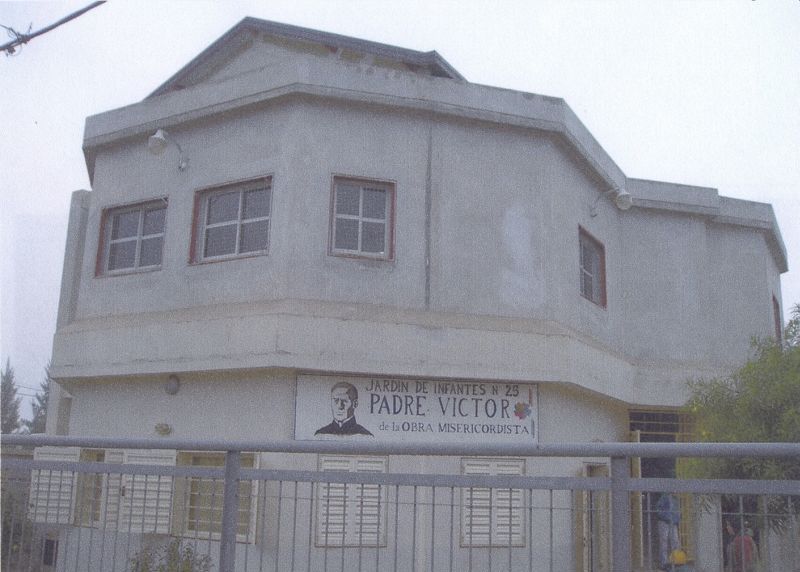
From 12 December 1935 there is a community in Santiago del Estero, originally linked with the agrarian school San José, that now became the Colegio San José and also furnishes university/higher education. Besides that educational Institute, the community is also linked with La Misericordia, a primary school with infants as well, with Padre Victor, a little infant school and with social work in the slums., with San Vincente, a primary school and Comedor as social work, also in the slums.
A fertile meeting
The tradition tells that Mgr. Rodriguez y Olmos, who was then bishop of Santiago del Estero in the thirties, couldn’t possibly convince the Provincial direction to make religious education obligatory in the primary schools of provincial right. There also exist schools of national right and totally free schools: colleges or institutes.
On his first visit at limina, Mgr. Rodriguez y Olmoz met Brother Attorney General Damaso in the lobbies of the Vatican. Brother Damaso probably thought of the rich uncle from America to solve his financial difficulties. The Monsignor also probably thought of a happy and cheap way to remove his school problems. Both parties then concluded a contract: the Monsignor would take care of the necessary buildings and he would cover the first expenses. To start Brother Damaso would send three Brothers.
The first friars in Argentina
After he had returned to his country of birth, the bishop defended himself so strongly that the involved authorities soon adjudged half a million pesos to construct a college and a convent. He immediately telegraphed this fabulous news to Rome. Under the impulse of Brother Superior Leonard and of Brother Attorney General Damaso, and with the special blessing of Pope Pius XI, three Italian Brothers-missionaries, crossed the Atlantic Ocean in 1931.
Having arrived in Buenos Aires, the missionaries heard that one of the periodical returning revolutionaries had just ended. That meant that the previous president didn’t have had the opportunity to sign the decree concerning the subsidies for Santiago and that his successor made a clean sweep of all the conclusions of the last government.
Our Brothers-missionaries didn’t find a house nor a bed, no table, fork nor knife. But it didn’t take long before they opened a school with a resident and a non-resident part in a house: a first year of the primary school with five resident and six non-resident pupils.
The University

At the end of the year 1935 the Brothers in Santiago del Estero opened an agricultural school. And in 1960 even a real university was founded: the Instituto Universitario, the third CATHOLIC university in Argentina. In March 1962 Brother Superior Jaak personally appointed the new headmaster, Professor Dr. Niessen, a priest from Bonn, in substitution for the present headmaster Brother Hermas De Bruyn.
As he was an excellent organizer and an apostolic thinker, the new headmaster immediately started his important task with a searching inquiry of the materialistic and the social possibilities. This study lead to a concrete planning and a timing for further expansion. The reputation of Dr. Niessen in West-Germany, as well as his many friends in official and Christian quarters, procured him the necessary help to run the young university, also financially.
The university was taken over in 1969 by a civil association that had as much input as the friars concerning nominations.
Belgian reinforcement
It is in this complex of schools in Santiago del Estero that two Belgian Brothers have made themselves simply irreplaceable: Brother Octaaf and Brother Hermas De Bruyn.
Brother Octaaf left by boat from Antwerp 1st of September 1949 and thirty days later he arrived in Montevideo. He remained here till 8th of February of the next year to qualify in the Spanish language. At the end of September 1946 , Brother Hermas returned to Rome hoping that he could embark there for Montevideo. For nine months he waited there vainly because all the places were regularly taken by releasing American soldiers.
Meanwhile Brother Hermas learned to read, speak and write Spanish perfectly so that it was no lost time. 20 June 1947, a transatlantic boat brought him via Genua to Montevideo and 15th of July his Italian colleagues welcomed him in Santiago.
Besides their already tough task as a teacher, there was also the active participation in the apostleship in lots of works after school. In 1963 they already had about 30 doctors, engineers and lawyers shaped into well-grounded and strongly believing laymen apostles.





